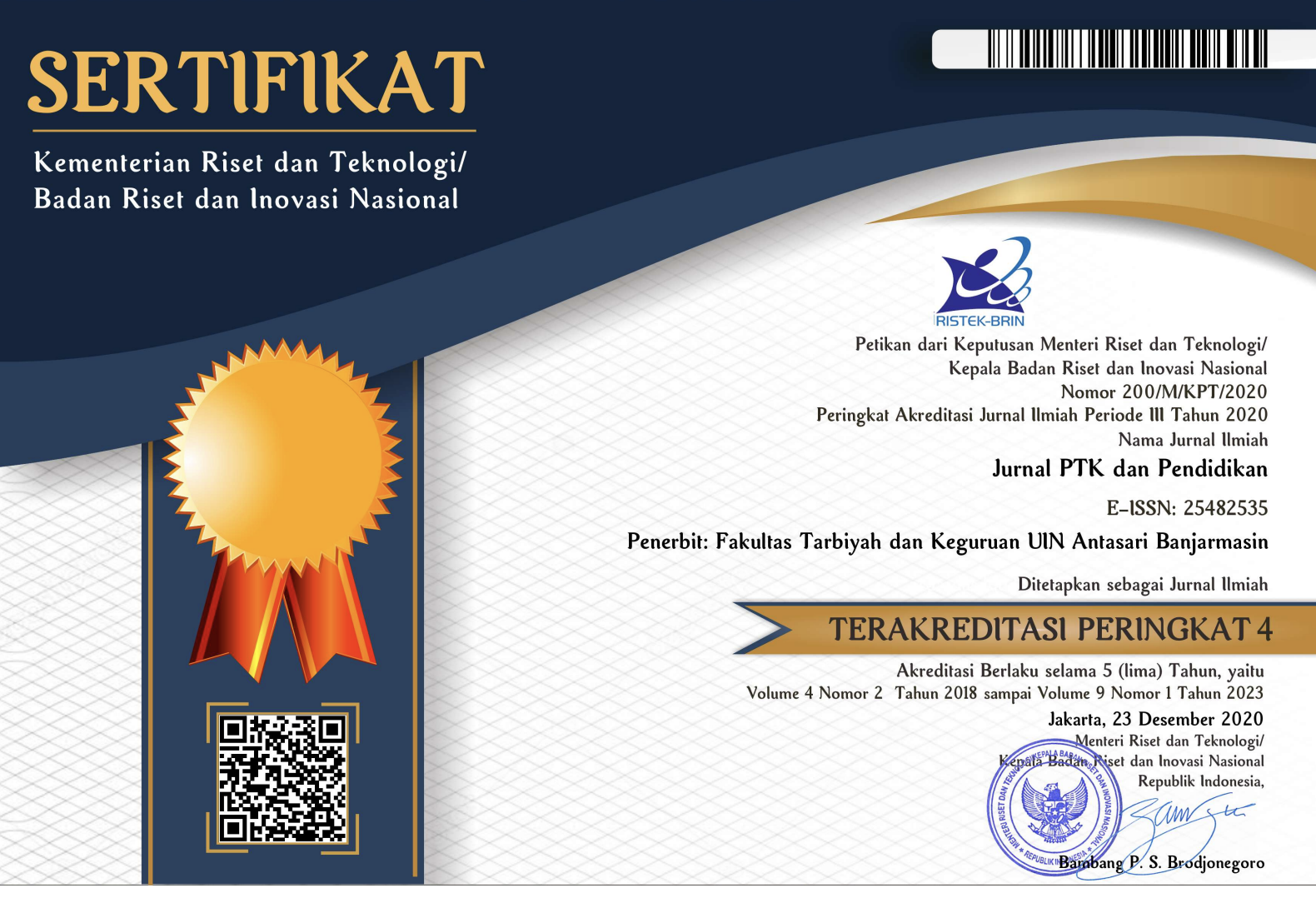Peningkatan Pemahaman Siswa Terhadap Teks Eksposisi Melalui Strategi Membaca Pemahaman SQ3R pada Siswa Kelas VII Mts Wachid Hasyim Surabaya
DOI:
https://doi.org/10.18592/ptk.v7i2.4497Abstract
Based on preliminary study, it was found that 62% of students at the seventh grade of MTs Wachid Hasyim Surabaya were not able to answer inferential and referential question to fulfil reading comprehension. Therefore, this study used classroom action research by implementing Survey, Question, Read, Recite, dan Review (SQ3R) reading strategy to improve students’ ability in reading comprehension. This research was conducted in two cycles. The result showed that 83% students were able to answer inferential and referential question to understand the text at the first cycle and 97 % at the second cycle. It means that there was an increase of 14% from the first cycle to the second cycle. Meanwhile, 79% students had reached mastery learning to rewrite the text on students’ own language.References
Ameliana, I. (2017). Teacher-centered or Student-centered Learning Approach to Promote Learning? Jurnal Sosial Humaniora, 10(2), 59. https://doi.org/10.12962/j24433527.v10i2.2161
An, S. (2013). Schema Theory in Reading. Theory and Practice in Language Studies, 3(1). https://doi.org/10.4304/tpls.3.1.130-134
Baier, K. (2011). The Effect of SQ3R on Fifth Grade Students’ Comprehension (Green State University). Green State University. Retrieved from http://rave.ohiolink.edu/etdc/view?acc_num=bgsu1300677596
Bulut, A. (2017). Improving 4th Grade Primary School Students’ Reading Comprehension Skills. Universal Journal of Educational Research, 5(1), 23–30. Retrieved from https://eric.ed.gov/?id=EJ1124667
Falah, I. F. (2014). Model Pembelajaran Tutorial Sebaya. Jurnal Pendidikan Agama Islam_Ta’lim, 12(2). Retrieved from www.damandiri.or.idfileabdwahidchairulahunairbab2.pdf,
Grove, N. P., & Lowery Bretz, S. (2012). A Continuum of Learning: From Rote Memorization to Meaningful Learning in Organic Chemistry. Chemistry Education Research and Practice, 13(3), 201–208. https://doi.org/10.1039/c1rp90069b
Gürlen, E. (2012). Meaningful Learning and Educational Environment. In Journal of Education and Future (Vol. 1).
Harshman, J., & Stains, M. (2017). A Review and Evaluation of the Internal Structure and Consistency of the Approaches to Teaching Inventory. International Journal of Science Education, 39(7), 918–936. https://doi.org/10.1080/09500693.2017.1310411
Harvey, S., & Goudvis, A. (2011). Scaffolding The Primary Comprehension Toolkit for English Language Learners: Previews and Extensions to Support Content Comprehension. FirstHand.
Joyo, A. (2018). Gerakan Literasi dalam Pembelajaran Bahasa Indonesia Berbasis Kearifan Lokal Menuju Siswa Berkarakter. Jurnal Kajian Bahasa, Sastra Dan Pengajaran (KIBASP), 1(2), 159–170. https://doi.org/10.31539/kibasp.v1i2.193
Marina, L., Acosta, E., Ferri, M. M., & Ferri, M. (2010). Reading Strategies to Develop Higher Thinking Skills for Reading Comprehension . PROFILE, 12(1), 107–123.
Oakhill, J., Cain, K., & Elbro, C. (2015). Understanding and Teaching Reading Comprehension: A Handbook. New York, USA: Routledge.
Palobo, M., Sianturi, M., Marlissa, I., Purwanty, R., Dadi, O., & Saparuddin, A. (2020). Analysis of Teachers’ Difficulties on Developing Curriculum 2013 Lesson Plans. Proceeding of the 1st International Conference on Social Studies, 1319–1324. Atlantis Press. https://doi.org/10.2991/icss-18.2018.278
Rokhmawan, T. (2018). Konteks, Tema, Skemata, Memori, dan Pikiran : Mendukung Pembelajaran Bahasa Sebagai Penghela Ilmu Pengetahuan. Hasta Wiyata, 1(2), 12–29. https://doi.org/10.21776/ub.hastawiyata.2018.001.02.02
Sanjaya, W. (2016). Penelitian Tindakan Kelas. Jakarta: Prenada Media.
Downloads
Published
How to Cite
Issue
Section
License
- The right to publication of all journal material published on the Jurnal PTK dan Pendidikan website is held by the editorial board with the author's knowledge (moral rights remain the property of the author).
- The formal legal provisions for access to digital articles of this electronic journal are subject to the terms of the Creative Commons CC BY 4.0 DEED Attribution International (CC BY) license. This license enables reusers to distribute, remix, adapt, and build upon the material in any medium or format, so long as attribution is given to the creator. The license allows for commercial use.
- Printed and electronic published manuscripts are open access for educational, research and library purposes. In addition to these objectives, the editorial board shall not be liable for violations of copyright law.






